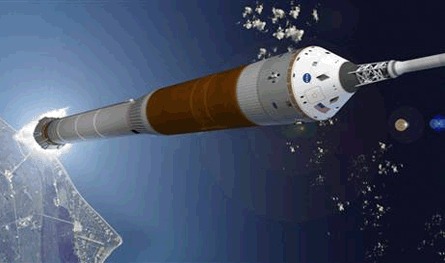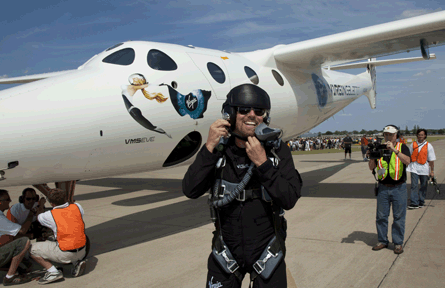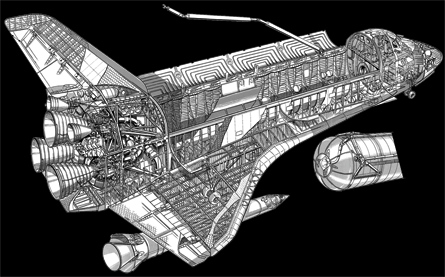As the Space Shuttle programme slowly winds to a close in 2011, the question on the mind of every space enthusiast in the USA and beyond is "what comes next?"
The International Space Station is nearly complete after more than a decade of effort and the expectation is for it to remain in service with US involvement until 2020. The lifespan of the ISS, combined with renewed talk of sending manned flights back to the Moon or even beyond, to Mars, makes the need for a reusable vehicle obvious.
Without the Shuttle or even a clear path - and funding - to a replacement, the future of the US manned spaceflight programme is murky at best. But despite uncertain funding and changing schedules, NASA and the aerospace industry continue to forge ahead with new ideas for getting humans into space after the Shuttle.
 |
|---|
© NASAAres V: designed to be a heavylift booster |
When the Columbia orbiter broke apart on re-entry on 1 February 2003, killing all seven crew members, due to damage to the thermal protection system during take off, then-president George Bush and his administration spent a year evaluating the costs, risks, direction and importance of the manned spaceflight programme.
A year later, the president declared space exploration vital to the national interest and announced an ambitious plan to not only return to the Moon, but to venture as far as Mars.
Columbia's crew did not turn away from a challenge, and neither will we," Bush said. "Mankind is drawn to the heavens for the same reason we were once drawn into unknown lands and across the open sea."
Within the year, NASA's ambitious and expensive Constellation programme was born. Constellation's stated goals from the programme office as recently as 2009 are to "gain significant experience in operating away from the Earth's environment, develop technologies needed for opening the space frontier, and to conducting fundamental science. More specifically, Constellation was intended to include the development of spacecraft and booster vehicles to replace the Shuttle, return US astronauts to the Moon and eventually beyond.
MISSION HARDWARE
Two boosters - Ares I and Ares V - would launch mission crews into orbit and serve as a heavylifter for mission hardware, respectively. The programme also includes the Orion crew capsule, the Earth Departure Stage and the Altair lunar lander. In 2006, Lockheed Martin was selected to build Orion, the crew compartment for Constellation and Earth orbit missions, with Boeing providing the primary heat shield.
Although Bush intended for the crew exploration vehicle to be more or less developed by 2008 and flying its first manned mission no later than 2014, Congressional funding faltered, followed by confidence and support. In spite of pouring about $9 billion into the development of the Constellation's Ares rockets and Orion crew capsule, costs continued to balloon and timelines shifted to the right. Without the momentum from a huge push of national will that the Apollo programme enjoyed, Constellation - and talk of returning humans to the Moon - fizzled out.
 |
|---|
© NASAAres I: designed to launch mission crews |
By the time he got to the White House in 2009, President Barack Obama's intentions were clear and Constellation was all but dead. Obama's fiscal year 2011 budget proposal did not include funding for the programme and in March 2010, NASA began shutting it down in accordance with the president's directive.
POLICY TURN
But a month later, the future was neither as grim nor as clear. On 15 April, US space policy took another sharp turn. Obama directed NASA administrator Charles Bolden to immediately take the already-developed Orion technology and begin developing a rescue vehicle.
As the Obama administration's space policy has developed, it has meant hope for more than just Constellation and its components. While Bush-era space policy took a more unilateral approach to US activities in space, the new policy emphasises international co-operation, particularly when it comes to sharing the costs and risks and space security issues.
Also bucking Bush policy, the USA now plans to extend participation in the ISS to 2020 instead of cutting it off at 2015 - even without laying out a domestically based, reliable way of getting there after the Shuttle's retirement.
Obama intends to make space more of a diplomatic issue. "The secretary of state, after consultation with the heads of appropriate departments and agencies, shall carry out diplomatic and public diplomacy efforts to strengthen understanding of, and support for, US national space policies and programmes and to encourage the foreign use of US space capabilities, systems, and services," his June policy statement says.
The new policy calls for shifting "routine, operational space functions" from the government to commercial sector and developing government space systems "only when it is in the national interest and there is no suitable, cost-effective US commercial or, as appropriate, foreign commercial service or system that is or will be available".
Supporting, rather than competing with the commercial spaceflight industry is a vital part of the USA's future in space, Obama says.
"This policy is about the boundless possibilities of the future. That is why we seek to spur a burgeoning commercial space industry, to rapidly increase our capabilities in space while bolstering America's competitive edge in the global economy," he says.
The move is not the first time the government has sought commercial help in building the next generation of vehicles for manned spaceflight. Flirtations with commercial development yielded some progress from both Lockheed and Boeing, the former with the X-33 and VentureStar projects and the latter with the Orbital Space Plane (OSP) and the X-37, although neither programme went beyond the unmanned stages, albeit for different reasons.
NASA and Lockheed planned to demonstrate a viable single-stage-to-orbit design, highly reliable and safe aircraft that did not require external fuel tanks or booster rockets to achieve low-Earth orbit. The X-33 was meant to take off vertically and horizontally.
 |
|---|
© Lockheed MartinThe Lockheed Martin X-33 VentureStar would take off vertically and land horizontally |
Lockheed intended to eventually extrapolate the subscale demonstrator out into VentureStar, a commercial endeavour reusable unmanned spaceplane for launching satellites that could also carry people as cargo, leasing that option to NASA as needed. Problems arose with X-33s and NASA cancelled the programme in 2001 after a nearly $1.3 billion investment between the space agency and the company.
Lockheed has since rechristened the prototype the "Space Reusable Launch Vehicle," quietly conducting tests with a new rocket at Spaceport America in New Mexico from 2007 until late 2009, crashing once in August 2008 after as 12s flight.
The Orbital Space Plane was intended to fulfil ISS crew rescue and contingency cargo requirements. When Constellation began, some of the technology went to the programme's crew exploration vehicle effort. A component of the OSP effort, Boeing's X-37, an unmanned reusable spaceplane, was transferred from NASA's books to the Defense Advanced Research Projects Agency in September 2004.
Nevertheless, commercial space ventures persist, most famously with Sir Richard Branson and Virgin Galactic. He intends to provide suborbital spaceflights to the public for $200,000 a ride, with the occasional science mission, with hopes to expand to orbital flights and even the launch of small satellites.
 |
|---|
But Virgin Galactic is not aiming to make trips to the space station or even all the way to low-Earth orbit, especially at the outset. This is not the case with Eric Anderson's Virginia-based Space Adventures, which has already taken seven paying customers into orbit - most recently the Cirque du Soleil founder Guy Laliberté, who paid around $40 million for his 2009 12-day trip to space.
In September, Anderson and Boeing announced a partnership to ferry non-government passengers to the ISS. "Our first obligation is to NASA, but we look at the current circumstances as an opportunity to leverage what the government is doing into more non-governmental space business," says Brewster Shaw, former astronaut and vice-president and general manager of Boeing's space exploration division.
"We want to be able to take advantage of that opportunity. And to the degree that we are involved in human spaceflight programmes, that gives us an opportunity that is a better opportunity than some others."
The exclusive deal with Space Adventures would make commercially available empty seats on the seven-passenger capsule Boeing is developing to take crew members to ISS after the Shuttle programme closes next year. NASA typically sends four new crew members to the ISS at a time, which would leave three seats per CST-100 flight for Space Adventures to sell for an as-yet undisclosed price, the companies say.
Space Adventures has sent seven customers into space aboard the same Russian Soyuz spacecraft on which the USA will rely for ISS trips between the final Shuttle mission and the first flight of the next-generation capsule, which is expected in 2015 at the earliest.
Four test flights are expected until 2014, with the first flight in 2015, depending on federal funding streams. "We're ready now to start talking to prospective customers. The earlier we start talking to people, the better," says Anderson, who "politely objects" to the term "space tourist" in reference to Space Adventures' clients going to the ISS.
"It's not really the case that a bunch of people show up to the station in their flowered t-shirts with sunglasses on," he says. "This is much more about private citizens who are opening the frontier alongside government space explorers and are doing so in a very serious fashion."
The Space Adventures deal was only Boeing's most recent foray into the commercial space arena. At the Farnborough air show in July, the company announced it would team with Bigelow Aerospace - already a partner on capsule development - to build a low-Earth orbit commercial space station by 2015.
But with the Space Adventures deal and the Bigelow space station plan, the commercial ventures are still very open about the requirement of public funding to close the business case. Human spaceflight remains very much in need of government investment.
"With Boeing investment only, we would not be able to close the business case," says John Elbon, vice-president and programme manager of Boeing's commercial crew transport system, echoing statements made by the Boeing team about the Bigelow deal in July. "There are a lot of variables. Certainly more funding would be better. NASA has to decide how many providers they are going to carry through development."
 |
|---|
The Bigelow project's aggressive schedule - with assembly in 2014 and testing to include an uncrewed trip to the station - was contingent upon the US Congress coming through with funding for NASA's proposed Commercial Crew Development Space Act Agreement.
Both the US House of Representatives agreed to the more expensive Senate version of the three-year, $58 billion reauthorisation bill for NASA, hours before the close of FY2010.
The measure authorises about $1.6 billion for commercial space transport up to 2013 and another $500 million on facilities and workers to keep open the option of another Shuttle flight. It includes $7 billion to get a heavylift launcher operational by 2016 to take cargo to the ISS as well as propel deeper space missions.
DEEP-SPACE MISSIONS
Manned missions are not the sole focus of the measure. Congress would prefer NASA focus on robotic deep-space missions, although the bill includes a tentative plan to land humans on an asteroid by 2025.
The true test for near-term space funding and manned missions is yet to come. The authorisation bill only marks the annual funding caps for NASA and its activities. When lawmakers return to Washington for the annual end-of-year scramble to get funding bills and other legislation out the door rapidly, they still hold the option of approving actual spending below the authorised limits.
Source: Flight International



















